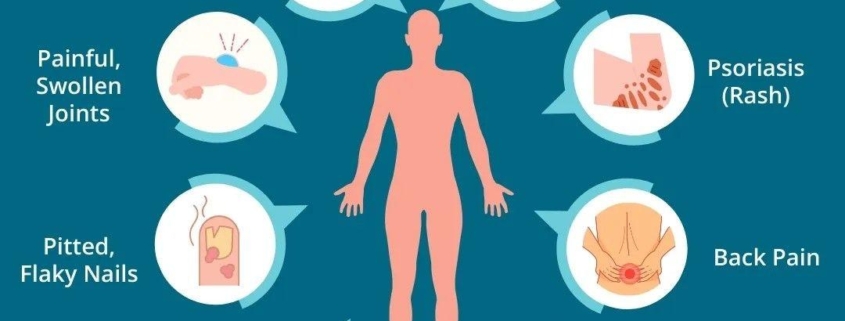
Psoriatic Arthritis
Overview of Psoriatic Arthritis
Psoriatic arthritis is a type of arthritis that affects some people who have psoriasis, a condition characterized by red patches of skin topped with silvery scales. Recent studies estimate that nearly 30% of people with psoriasis develop psoriatic arthritis. This condition causes inflammation in the joints, leading to pain, swelling, and stiffness. While it can affect any part of your body, it often impacts the hands, feet, neck, spine, and sacroiliac joints (pelvis area).
Types of Psoriatic Arthritis
There are five major types of psoriatic arthritis:
-
- Asymmetric oligoarticular: Affects joints on one side of your body.
-
- Symmetric polyarthritis: Affects the same joints on both sides of your body.
-
- Spondylitis: Causes inflammation and stiffness in your neck, spine, and lower back.
-
- Distal interphalangeal predominant (DIP): Affects the distal joints, which are the finger and toe joints closest to the nail.
-
- Arthritis mutilans: A severe, destructive form that can cause bone damage.
Causes of Psoriatic Arthritis
While the exact cause of psoriatic arthritis isn’t fully understood, it’s thought to be linked to a combination of genetic, environmental and immune factors. Individuals with a family history of psoriasis or psoriatic arthritis are more at risk of developing the condition. Furthermore, bacterial or viral infections might trigger the disease in susceptible individuals.
Symptoms of Psoriatic Arthritis
Psoriatic arthritis symptoms can vary in intensity and can even come and go. Here are some common signs:
-
- Joint pain and swelling
-
- Skin patches and nail changes
-
- Reduced range of motion
-
- Tendon or ligament pain
-
- Fatigue
-
- Eye inflammation
Diagnosis of Psoriatic Arthritis
Diagnosis is often a process of elimination. Physicians typically utilize various tests to rule out other conditions. Blood tests are a common diagnostic tool, as are imaging tests such as X-rays or MRI scans. Physical examination, reviewing the patient’s medical history, and a comprehensive evaluation of symptoms also play a key role in the diagnosis.
Treatment Options for Psoriatic Arthritis
The primary goals of treating psoriatic arthritis are to control inflammation, slow down the progression of the disease, and improve the quality of life. Here’s a brief rundown of possible treatment options:
-
- Nonsteroidal anti-inflammatory drugs (NSAIDs): Help to reduce pain and inflammation.
-
- Disease-modifying antirheumatic drugs (DMARDs): Slow the progression of psoriatic arthritis and protect the joints and other tissues from permanent damage.
-
- Immunosuppressants: Control the immune system.
-
- Biologics: Target specific parts of the immune system.
-
- Physical Therapy: Exercises can help keep your joints flexible.
-
- Surgery: In severe cases, joint replacement surgery can be carried out.
Living with Psoriatic Arthritis
Managing psoriatic arthritis may require some lifestyle adjustments. Regular exercise, a healthy diet, quality sleep, and stress management strategies can all help in managing the condition. Also remember to take medication as prescribed by your doctor, attend all scheduled doctor’s appointments, and maintain open communication about any changes in symptoms or overall health.
When to Seek Help for Psoriatic Arthritis
If you have psoriasis and start to experience joint pain, stiffness, fever, or fatigue, make sure to seek medical attention right away. Early diagnosis and intervention can prevent joint damage and preserve quality of life. Also, if symptoms worsen or you experience side effects from medication, it is important to discuss these changes with your doctor.
Remember, while it’s not currently possible to prevent psoriatic arthritis, being proactive about your health can significantly improve your wellness and comfort. Reach out to healthcare providers and supportive communities for help when you need it, and know that you are not alone on your journey with psoriatic arthritis.
Please note that this guide is intended for informational purposes only and is not a substitute for professional medical advice, diagnosis, or treatment. Always seek the advice of your physician or other qualified health provider.
